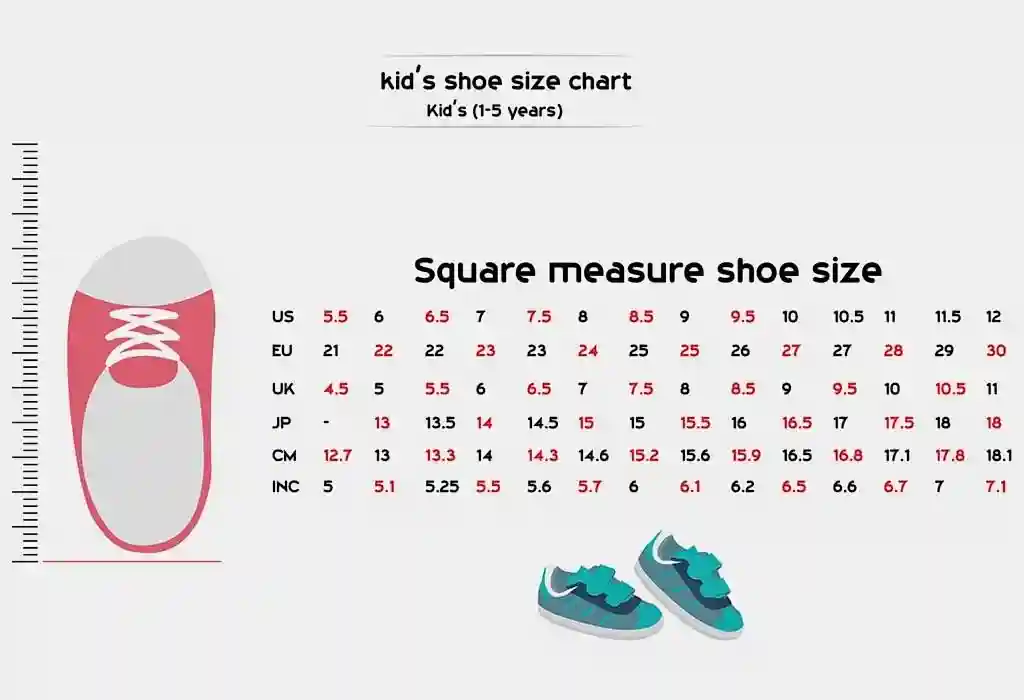Baby Shoe Size Chart: Guide for Parents
Finding the right shoe size for your little one can be challenging. With rapidly growing feet and varying sizing standards, it’s crucial to have a reliable baby shoe size chart at your disposal. This comprehensive guide will help you navigate the world of baby footwear, ensuring your child’s feet are comfortable and properly supported.
Why is a Baby Shoe Size Chart Important?
Before diving into the specifics of baby shoe sizes, let’s understand why using a proper baby shoe size chart is essential:
- Promotes healthy foot development
- Prevents discomfort and potential foot problems
- Ensures a good fit as your baby grows
- Helps you make informed purchasing decisions
Understanding Baby Shoe Sizes
Baby shoe sizes can vary depending on the country and manufacturer. Here’s a breakdown of the most common sizing systems:
US Sizing System
The US sizing system is one of the most widely used for baby shoes. It typically ranges from size 0 to 13.5 for infants and toddlers.
UK Sizing System
UK sizes are generally one size smaller than US sizes. They range from 0 to 13 for babies and young children.
EU Sizing System
European sizes are based on the length of the foot in centimeters. For babies, they usually start around size 16 and go up to 28.
Baby Shoe Size Chart: Age to Size Conversion
While every child grows at their own pace, here’s a general baby shoe size chart to give you an idea of how shoe sizes correspond to age:
| Age | US Size | UK Size | EU Size |
|---|---|---|---|
| 0-3 months | 1 | 0.5 | 16 |
| 3-6 months | 2 | 1 | 17 |
| 6-9 months | 3 | 2 | 18 |
| 9-12 months | 4 | 3 | 19 |
| 12-18 months | 5 | 4 | 20 |
| 18-24 months | 6 | 5 | 22 |
Remember, this baby shoe size chart is a general guide. Always measure your baby’s feet for the most accurate sizing.
How to Measure Your Baby’s Feet
To use a baby shoe size chart effectively, you need accurate measurements. Follow these steps:
- Gather materials: You’ll need paper, a pencil, and a ruler.
- Trace the foot: Place your baby’s foot on the paper and trace around it.
- Measure length: Use the ruler to measure from the heel to the longest toe.
- Measure width: Measure the widest part of the foot.
- Add allowance: Add about 0.5 inches (1.27 cm) to allow for growth.
Factors Affecting Baby Shoe Sizes
When using a baby shoe size chart, keep in mind that several factors can influence the fit:
- Growth spurts: Babies’ feet can grow rapidly, sometimes up to half a size every two months.
- Time of day: Feet tend to swell slightly as the day progresses.
- Sock thickness: Thicker socks may require a slightly larger shoe size.
- Brand variations: Different brands may have slight variations in their sizing.
Baby Shoe Size Chart by Foot Length
For the most accurate sizing, use this baby shoe size chart based on foot length:
| Foot Length (inches) | Foot Length (cm) | US Size | UK Size | EU Size |
|---|---|---|---|---|
| 3 1/8 | 8 | 0 | 0 | 15 |
| 3 1/4 | 8.3 | 1 | 0.5 | 16 |
| 3 1/2 | 8.9 | 2 | 1 | 17 |
| 3 5/8 | 9.2 | 2.5 | 1.5 | 18 |
| 3 3/4 | 9.5 | 3 | 2 | 18 |
| 4 | 10.2 | 4 | 3 | 19 |
| 4 1/8 | 10.5 | 4.5 | 3.5 | 20 |
| 4 1/4 | 10.8 | 5 | 4 | 20 |
| 4 1/2 | 11.4 | 5.5 | 4.5 | 21 |
| 4 5/8 | 11.7 | 6 | 5 | 22 |
| 4 3/4 | 12.1 | 6.5 | 5.5 | 23 |
Tips for Using a Baby Shoe Size Chart
To get the most out of your baby shoe size chart:
- Measure regularly: Check your baby’s foot size every 6-8 weeks.
- Measure both feet: Use the larger foot for sizing if there’s a difference.
- Consider width: Some babies may need wide or narrow options.
- Allow room for growth: Choose shoes with about 0.5 inches of extra space.
- Check the fit: Ensure there’s enough wiggle room for toes.
Common Baby Shoe Types and Their Sizing Considerations
Different types of baby shoes may have unique sizing considerations. Here’s how to approach sizing for various shoe types:
Soft Sole Shoes
Ideal for pre-walkers, these shoes should:
- Fit snugly but not too tight
- Allow toes to grip and spread naturally
- Have a flexible sole for unrestricted movement
First Walker Shoes
As babies start to walk, look for shoes that:
- Provide more support than soft sole shoes
- Have a slightly firmer sole for protection
- Still allow for natural foot movement
Sandals
When using a baby shoe size chart for sandals, remember:
- Straps should be adjustable for a secure fit
- Toes shouldn’t hang over the edge
- The heel should be snug but not tight
Boots
For baby boots, consider:
- Extra room for thick socks in cold weather
- Ease of putting on and taking off
- Ankle support without restricting movement
The Importance of Proper Fit
Using an accurate baby shoe size chart is crucial for several reasons:
- Foot Development: Properly fitted shoes support natural foot growth and development.
- Comfort: Well-fitting shoes prevent blisters, corns, and other discomforts.
- Balance and Coordination: The right size helps babies maintain balance as they learn to walk.
- Long-term Foot Health: Avoiding ill-fitting shoes in infancy can prevent foot problems later in life.
When to Size Up
Keep an eye out for these signs that it’s time to consult your baby shoe size chart for the next size:
- Toes touching the front of the shoe
- Difficulty putting on or removing shoes
- Red marks or indentations on the feet after wearing shoes
- Your baby seems uncomfortable or fusses when wearing shoes
- Shoes feel tight when you press on the toe area
Seasonal Considerations for Baby Shoe Sizing
As seasons change, so might your baby’s shoe needs. Here’s how to adapt your use of the baby shoe size chart throughout the year:
Summer
- Consider going up half a size to accommodate swelling in hot weather
- Look for breathable materials to keep feet cool
Winter
- Allow extra room for thick socks
- Ensure boots are not too restrictive, even with warm linings
Spring and Fall
- These transitional seasons are ideal times to reassess shoe size
- Be prepared for potential growth spurts
International Travel and Baby Shoe Sizes
If you’re traveling internationally, understanding different sizing systems is crucial. Here’s a quick reference for popular destinations:
- USA to EU: Add 31 to 33 to the US size
- UK to US: Add 0.5 to 1 to the UK size
- Japan: Uses centimeters, similar to EU sizing
Always consult a comprehensive baby shoe size chart when shopping in different countries.
The Debate: Shoes vs. Barefoot for Babies
While a baby shoe size chart is essential for choosing the right footwear, there’s ongoing debate about whether babies need shoes at all before they start walking. Here are some points to consider:
Benefits of Barefoot:
- Allows natural foot development
- Strengthens foot muscles
- Improves balance and coordination
When Shoes are Necessary:
- Protecting feet outdoors
- Keeping feet warm in cold weather
- Supporting feet when walking on rough surfaces
Consult with your pediatrician for personalized advice on when to introduce shoes.
Caring for Baby Shoes
To get the most out of your baby’s shoes:
- Rotate shoes: Alternate between pairs to extend their life
- Clean regularly: Follow manufacturer’s instructions for cleaning
- Air out: Let shoes dry completely between wears
- Check for wear: Replace shoes that show signs of significant wear
Common Mistakes When Using a Baby Shoe Size Chart
Avoid these pitfalls when sizing your baby’s shoes:
- Assuming all brands use the same sizing
- Buying shoes to “grow into”
- Neglecting width measurements
- Not accounting for sock thickness
- Forgetting to re-measure regularly
The Future of Baby Shoe Sizing
As technology advances, we’re seeing innovations in baby shoe sizing:
- 3D foot scanning for precise measurements
- Smart shoes that adjust to foot growth
- AI-powered size prediction based on growth patterns
While these technologies are exciting, a reliable baby shoe size chart remains an essential tool for most parents.
Conclusion
using a comprehensive baby shoe size chart is crucial for finding the right fit for your little one. By regularly measuring your baby’s feet and paying attention to their comfort, you can ensure proper foot development and mobility. This guide equips you with the knowledge needed to make informed decisions about baby footwear, whether for a first pair or as your child grows.







